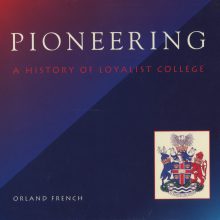The excerpts below are from author Orland French’s book, PIONEERING: A History of Loyalist College (1992). While some references are no longer current, the publication provides a rich report on Loyalist’s history, which helps to contextualize its milestones.
Loyalist Separated From Twin At Birth
Loyalist College was originally born as a twin of Sir Sandford Fleming College in Peterborough. They were separated shortly after birth. Fertile bureaucratic minds in the Ministry of Education in Toronto had divided the province into geographic regions, allotting one community college per area. Belleville was to share Area 3 with Peterborough. A single college would serve the Counties of Hastings, Prince Edward, Northumberland, Lennox and Addington, Peterborough, Haliburton and Victoria.
Planning The College System
Lorne Johnston was a friend of Loyalist College even from the beginning. With sentimental family ties to the Belleville area, he had a special interest in seeing the Quinte Region acquire a college campus. His efforts were acknowledged when the College officially opened. Johnston received the first honorary diploma to be awarded by an Ontario community college.
Read More
Blowin’ In The Wind
When the Pioneer building was opened in 1968, the guest speaker might have taken solace in a popular song of that decade. His words of wisdom, committed carefully to paper, were literally “Blowin’ in the Wind”.
Lorne Johnston, representing the Ministry of Education, recalls, “It was a very windy day. We couldn’t get everyone inside the Pioneer building, so a platform was set up outside. I stepped up to the podium, removed the clip from my notes and – whoosh! – they were blown away into the cedars.”
He graciously invited the press to pick his notes out of the trees if they wanted a prepared text.
Bill Davis, Sod-Buster
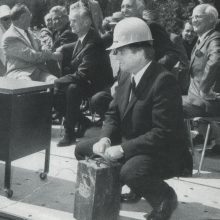 The day Bill Davis came to town was supposed to be “a real blast”. And it was. But only after an uncomfortable warm wait on a hot August afternoon in 1969. Loyalist had decided to begin the construction of its permanent building with a sod-blasting ceremony rather than the more sedate silver spaded sod turning.
The day Bill Davis came to town was supposed to be “a real blast”. And it was. But only after an uncomfortable warm wait on a hot August afternoon in 1969. Loyalist had decided to begin the construction of its permanent building with a sod-blasting ceremony rather than the more sedate silver spaded sod turning.
Who Are We?
The first graduates of community colleges suffered an identity crisis. No one knew for sure what the colleges were capable of producing and students were aware of this uncertainty. The new colleges would not provide the academic training of universities but they were more than trade schools. They were a new breed of post-secondary education intended to provide the training and skills required by the rapid developments in technology. But colleges had yet to prove themselves.
Pregnant Seagull
The original Loyalist logo, incorporating a stylized form of the letters LC to signify the lamp of learning, was derisively dubbed “the pregnant seagull” by staffers. When the 10th anniversary symbol was unveiled, many staff members embraced it as a new logo. But the Board of Governors ruled that the old logo would stay and the new symbol would become a “crest” for the College. Not insignificantly, the new colour symbol would have cost an additional $1,500 in printings costs for College stationery.
Quiet Dwells – The College In The Country
While Loyalist College may be outstanding in its field, staff and students alike have wondered just why it has been built “out standing in a field”.
Turn In Here
The 28-foot pylon at the entrance of the College was erected in 1975 to assist confused motorists who couldn’t easily find the main entrance. Pre-construction publicity said the pylon should be clearly visible from both Highway 401 and Highway 2.
This may have been a tad over-enthusiastic.
Enter By The Back Door
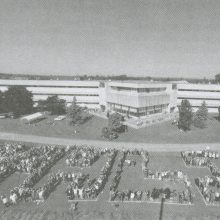
There’s no shame in saying you got into Loyalist College through the back door. The front door is still waiting for the road to arrive.
The Kente building of Loyalist College was built facing southeast in anticipation of the extension of Bridge Street to Avonlough Road. A road system which never materialized was intended to connect the College to Avonlough Road to the east and permit ready access to downtown Belleville and Prince Edward County.
Consequently, Loyalist presents its best face to the field and the forest behind it. From Wallbridge-Loyalist Road, visitors approach the College which appears to be housed in a long, low, one-storey building. They seldom see the seeping lines of the three-storey structure or the shimmer reflection of the glass-fronted lobby, as the architects intended.
After 25 years, the road to Avonlough is still a planner’s dream.
The Spirit Of Our Students

Across Canada and around the world, there are 12,000 people who can attest to the strengths and purpose of Loyalist College. They are not the teachers or the administrators, nor are they the government bureaucrats who determine the educational directions of the college system. These are the students who have graduated from Loyalist College over the past 25 years.
Many Moods On Film
Three Loyalist students covered nearly 9,600 kilometres of bush road and trails in the backwoods of eastern Ontario in 1974, creating a promotional film for the Moira River Conservation Authority. Tom New, Jan Zuchlinski and Maureen Hainje worked through the summer to produce a 15-minute film called Moods of the Moira, which was accompanied by a soundtrack of music by Moe Koffman.
Twenty-Three Skidoo!
Perhaps inspired by the movie They Shoot Horses, Don’t They? Loyalist students staged a dance marathon at Club Cedars in 1971. Men in ankle spats and women in flapper dresses danced to the music of the ‘20s provided by Kid Bastien’s Carmelia Jazz Band of Toronto. Fourteen couples began dancing at 9:00 p.m. and eleven were still going at midnight. Two hours later, only Sue Nagy and Tom Dekeyser were still on their feet – winning a trophy and a prize of a dinner for two.
Sounds Of Home

Thanks to Radio Broadcasting professor Steven Bolton, Canadian Forces personnel serving in the Gulf War got sounds from home over the 1990 Christmas season. Bolton organized shipments of radio programming from local radio stations to send to the Persian Gulf. Forty-three radio stations from across Canada contributed more than 138 hours of hometown news and information, talk shows, local gossip and special greetings from family members.
On the Record
The Pioneer, that stalwart weekly newspaper produced by the College’s Journalism program, is only the most recent chronicler of events on campus. One of the earliest publications was the pretentious sounding Nulli Secundus. It was a serious publication which reported the news and explored social issues. But when it began to probe into the extent of drug use in the Quinte Region in a series of articles in 1969, it learned that some people would rather “shoot the messenger” than hear the message.
In The Loyalist Tradition
His Excellency the Right Honourable Ramon John Hnatyshyn held two positions of particular interest for Loyalist College in 1992.
As head of the Canadian Heraldic Authority, he presented the College Coat of Arms at Convocation on June 10 to celebrate the 25th anniversary of the establishment of Loyalist College in 1967. And as Governor General of Canada, he represented a tie to an earlier ceremony at the College in which a previous Governor General, Roland Michener, had participated.
J. Kenneth Bradford
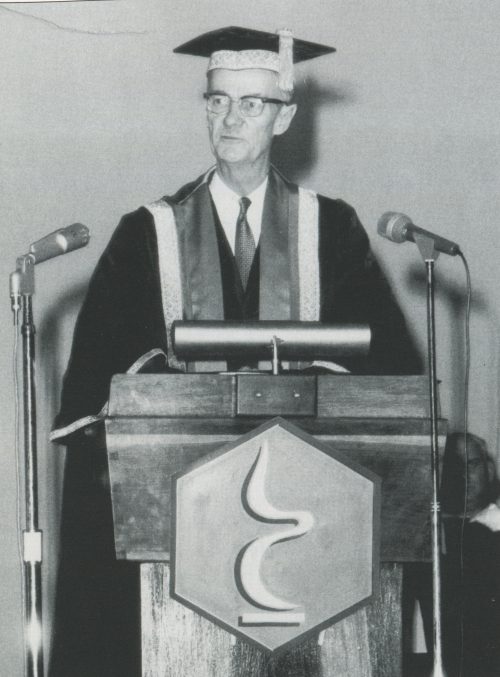
Col. J. Kenneth Bradford was hired in June 1967 to oversee the creation of a college. And quickly. Bradford was to have the College “up and running” within three months! The College was initially located in rented space at Centennial Secondary School in Belleville. Soon the College acquired land on Wallbridge Road, built the Pioneer building and opened for classes. Bradford had distinguished himself in World War II as Lieutenant Colonel and Corps Commander.
Judge J.C. Anderson
Judge J.C. Anderson, prominent in the Quinte Region, was a strong advocate of bringing a college to the Belleville area. When the joint Board with Sir Sandford Fleming College was created, he was appointed Vice-Chairman to represent the Loyalist campus. The Board was headed by the Reverend Henry Joseph Maloney of Bancroft.
Later, when a separate Board was created for Loyalist, Judge Anderson was named its first Chairman. He was a key figure in the site selection and building design of the College. Judge Anderson’s efforts have been honoured with the naming of the College library as the Anderson Resource Centre.
Herbert Young
Herbert Young brought to the President’s office an impressive list of credentials as an executive officer of a number of companies. He knew his way around the executive offices of Duplate of Canada in Oshawa, The Fiberglass Company of Canada in Sarnia, and Woods Gordon and Company, a large consulting company. He was also president of Dominion Forge of Windsor and Welmet Industries of Welland, a steel specialty manufacturer. Young’s role was to weld the rips and tears in the Loyalist shell and forge the College into a dynamic institution.
Douglas Auld
Before his appointment to the President’s office, Dr. Douglas Auld served as Executive Dean and Principal of Sir Sandford Fleming’s School of Natural Resources. Earlier, he had served as chair of the University of Guelph’s Economics department. Auld said he had been attracted by the College’s “outstanding reputation and its high-quality programs”.
First Father
The reverend Henry Joseph Maloney, parish priest of Bancroft, was so popular as a member of Loyalist’s board of governors that he wasn’t allowed to take mandatory retirement.
Of Affluence And Effluence
The messages of politicians, poets and prognosticators have please and provoked Loyalist students and staff over the years, offering insights into the breakup of Canada, the breakdown of society, the decline of affluence, and the increase of effluence.
Students On Air
Loyalist’s Broadcast Radio program was so successful in the early 1980s it couldn’t keep students in the classroom. Radio professor Bryan Olney, later dean of media studies, said that the radio industry snapped up first-year students who then did not return for second-year training.
“In most cases, the radio stations came looking for employees and the students didn’t have to apply,” Olney said.
Money, Money Everywhere
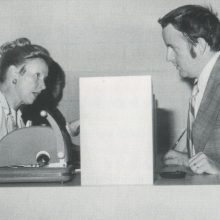
By Loyalist’s 25th year of operation, students could get money on campus from two locations: the Student Loans office and a “hole in the wall” known as an automatic teller.
On-site banking arrived at Loyalist in 1974 when the Bank of Montreal opened a branch managed by Mrs. Helen Melbourne. No electronic beep-beep was heard there; the teller was a real person with a live human voice.
Family Feuds At The Bargaining Table
The college community has not always been one big happy family.
Labour disputes and strikes have occasionally marred the first 25 years of Loyalist College, as negotiations with teachers as well as support staff came to an impasse. Teacher strikes in 1984 and in 1989, and a support staff strike in 1979, were the low points of labour-management relations in the college system.
Playing The Game
They changed the rules in Ontario college volleyball after Regyna Armonas played for Loyalist.
Doing Whatever Men Do
“I guess the life of a girl at Loyalist isn’t too bad. I suppose it is better to be thought of as ‘one of the guys’ rather than being looked down on as being a lesser member of college society.
—Published musings of a female student, April 1969.
Struggle For Freedom
Metamorphosis, a five-foot statue of a woman’s form breaking free of bonds, was unveiled in the Anderson Resource Centre in May 1989. The sculpture, by artist Audrey McNaughton of Oakville, was presented as a gift.
“The sculpture depicts the ongoing struggle for freedom of mind and body,” said McNaughton. “It’s symbolic of humankind’s struggle to attain its rightful heritage”.
Leave The Dustballs
“Don’t try to be a Super Wife. No one has to eat off your floor. There is no Great Housewife in the Sky who’s going to check if your beds aren’t made when you leave the house for work. Who are you cleaning for, anyway? Let it go! Your feeling of guilt will wear off around the time of your first job promotion.”
—Women’s advisor Karen Fraser in a lecture at Loyalist titled “Getting Yours”, January 1976.
Just One Of The Boys
Co-eds wear what they fancy and that seems to be blue jeans or pant suits. When a dress occasionally is worn, everyone seems so surprised that the girl wonders if she is in the right place. So, since the educational system is not bothered by their students’ apparel, girls will continue trying to be boys by wearing jeans and sporting short hair and trying to become liberated, and guys trying to be girls by letting their hair grow. The problem of distinguishing guys from girls certainly is not becoming any easier.”
– From the Pioneer, November 1971
Homes Away From Home
Horror Tales of housing “hassles” evolved year by year. Students rented large closets as bedrooms. Students slept in basements beside furnaces. Students rented makeshift apartments which failed to meet the normal standards of privacy and convenience. One student even claimed his shoelaces had been eaten overnight by a mouse!
Students Owned Belleville
A group of first-year college students came the ultimate landlords of Belleville in 1978. For a few moments, they owned the entire city. It was their prize trophy in a scavenger hunt on the College’s orientation day. Mayor Ben Corke agreed to sign over the entire city, then worth about $800 million, if they agreed to give it right back. They did.
Name That Building
The wings of the Kente Building were not always named after the counties served by the College. As they were constructed, they were assigned letters of the alphabet: “A” building, “B” building, etc. In 1973, the College decided to give the buildings names with a local historical flavour. Among names submitted for what eventually became the Pioneer building were: Lower Loyalist, Quinte(variation Kente), Erie Hall, Tyendinaga Building, and Lancer Lodge. Wallbridge Road gained its hyphenated addendum of Loyalist after lobbying by the board of governors.
No Fleas Allowed
Animals have been banned from campus since the College was set up. The only exceptions are rabbits and guinea pigs, which delight children in the Early Childhood Education Centre, and guide dogs for blind students. Queen’s University, a much older institution followed Loyalist’s example and banned animals in 1975 after it had to fumigate Theological Hall for fleas.
Tragedy On The Moira
The Moira River claimed a student’s life in April, 1972. David Thompson of Wellington drowned in the fourth – and last – “river run” when his raft went over Lazier’s dam. His companion, Garnet Bowers, was rescued.
The two Loyalist third-year technology students entered the Moira River Raft Run unofficially and tried to beat the river in a raft that did not satisfy organizers.
Here’s to Pub Nights
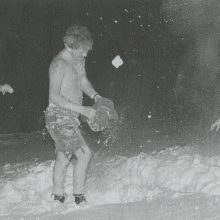
The “wets” and the “drys”, those political adversaries whose colourful battles have shaped the history of Ontario’s drinking laws, fought a skirmish on Loyalist’s turf.
Crying In Your Beer
In the mid-70s you could buy beer for 30 cents a draft. Honest. That was the price at the Canadian Hotel on Dundas Street where bottled beer only cost 55 cents. If you wanted to go a little more upscale, you could try The Green Door at the Quinte Hotel on Pinnacle where draft beer cost 60 cents. You’d be laying out 80 cents a shot if your preference was hard liquor.
Sir Sanford By Bus
There is a secret tale that rarely sees daylight. Though truth be told, the story can only be revealed under the cloak of anonymity. It is a tale of the growing pains of an immature institution and of students testing the limits of discipline.
Booknappers Foiled
Books no longer walked out of the library “on their own little legs” after an electronic security system was installed. The Anderson Resource Centre set up an electronic security system in 1974 after an inventory had discovered that 1,314 books had gone missing in action since the last inventory in 1971. The security system sounded a “gotcha” gong whenever someone tried to slip out of the library without properly checking out a book. The embarrassment of being caught was usually considered punishment enough.
World’s Oldest Working Student
James Bond had nothing on Charlie Benson. The fictional 007 detective had only a Double-0 rating while College Registrar Benson was a Triple-0
He was 0001, the Number One student at Loyalist.
The Maritime Connection
You can’t tell ‘em by their sou’westers, but there’s always a large crew of Maritimers running around the halls of Loyalist College.
It’s Lunch For Two: $5
In the days when a buck was a buck and not a looney, lunch could be had in Club 213 for a few dollars. A 1972 menu offered main courses: Poulet Saute au Vin Blanc ($1.60), steak ($2.00) or Pork Loin Provincale ($1.60). A seafood crepe appetizer was 45 cents. Dessert selections cost 25 cents. A drink from the bar cost 75 cents, while a whole bottle of an imported Yugoslavian wine could be bought for $4.50. A popular attraction was the $2.50 Friday buffet.
A Wee Bit Of Scotland
At one time there was an annual ritual in which Hotel students in Club 213 “killed the haggis” on Robbie Burns Day. But it did no good, for the haggis always returned for slaughter the next year.
The celebration was a gourmet’s delight, according to some. In 1980, the menu offered: Cauld Mandarin Prawn, Arbroath Smokie, hotch Potch, Haggis (minced sheep liver, heart and lungs boiled in maw), Poached Tay Sawmon, Braised Veal Flory, Kingdom of Fifa Pie, Biled Gigot with Caper Sauce, Stoved Tatties and Brussel Sproots.“Aye,” recalled course co-ordinator Fred (Mac)Goerke. “It was delicious.”
Clearing The Smoke
Winters are the worst for Loyalist’s smokers. Huddling in doorways, turning their faces away from the wind-driven snow, they fight to avoid freezing their “butts” in an ever-expanding smoke free environment.
Visitors From Afar
Established as a community college, Loyalist provides educational services to the counties of Prince Edward, Hastings, Lennox and Addington, and part of Northumberland. Add to that Nigeria, Venezuela, Botswana, Germany, Japan, Cuba, El Salvador . . .
College Opened Doors
Students with special needs found doors opening for them in 1988. A door at the main entrance to the Kente Building, one in the Quinte Industrial Training Centre and one in the Pioneer Building were fitted with sensors which, when activated, opened the doors automatically, Funding came form a grant from the Ministry of Colleges and Universities. The doors were part of ongoing retrofitting by the College to broaden accessibility to people with special needs. Wheelchair ramps were installed and a second elevator was built in the Northumberland Wing in 1992.
Tribute to Terry
Photography teacher Val Baltkalns dedicated one of his pictorial landscapes to Terry Fox, the one-legged runner who eventually lost his life to cancer.
Baltkalns, a teacher at Loyalist for 10 years, retired for health reasons on September 3, 1980 – the same day Terry Fox was forced to quit his cross-Canada run near Thunder Bay. The photograph depicted the rugged landscape along the north shore of Lake Superior. Baltkalns said he had the image in his mind’s eye long before he actually saw it. “I wanted to photograph a landscape that would express the ruggedness and beauty of Canada,” he said. “There was to be a trace of stark unfriendliness and hardship, and yet the awesome landscape had to provide a promise of hope for its people.”When he donated the picture to Fox as his personal Christmas present, Baltakalns said: “I deeply feel that it belongs to Terry, who uniquely displayed a true heroism in his day-today battle against excruciating pain in pursuit of his ideals.”
Baltkalns, a Fellow of the Royal Photographic Society, died in 1992.
Pioneering: A History of Loyalist College – Acknowledgements
This anecdotal and pictorial history of Loyalist College was compiled at the request of the Board of Governors in honour of the 25th anniversary of the College in 1992.





